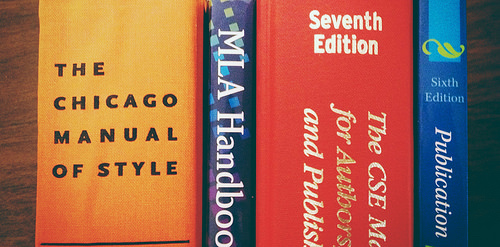Not sure where to start? Don’t know what a style guide is or why it’s important? Generally confused?
If you answered yes to any of those questions, you should first know that you’re not alone. Secondly, know that there are some wonderful resources you can turn to when you are confused. The Subversive Copyeditor by Carol Fisher Saller has been helpful for my own understanding of editing, specifically copyediting. If you’re curious about editing, finding books by editors can be useful in learning about the craft. Similarly, your colleagues are great resources for when you have questions. To get you started, here are five tips that are good for any type of editor to keep in mind.
1) Get to know the style guide.
-
- If you’re working for an established company, they’ll likely have some rules already in place. That’s exactly what a style guide is—a set of rules (these can always be broken, but it’s important to understand them first). Whether they work exclusively with the
Chicago Manual of Style
- or take what they like from several different style guides, you’ll need to know what references are necessary to edit the manuscript assigned to you. (Note: there are also in-house styles in addition to a general style guide.)
2) Do your research.
- After you’ve gotten all of your references and are able to sit down with the text, questions will probably arise. When this happens, you’ll want to determine whether the answer can be found with a quick browse through your guides or on the internet. If not, you may need to get clarification from another source.
3) Don’t be afraid to ask.
- Communication is key! Once you’ve determined that you can’t find the answer on your own, ask someone. If necessary, query the author, since they’re the most knowledgeable about their particular manuscript (though this should not be your first stop). Your colleagues or other professionals in the field are also excellent resources when you have questions about changes you’re making or need information about how to resolve an issue.
4) Know your assignment.
-
- What type of edit are you doing? Usually, you’ll be presented with a particular kind of edit: copyedit, proofread, or line edit. Once that is established, you may need to know what level edit you are tasked with. (For a general guide of copyedit levels check out
The Copyeditor’s Handbook: A Guide for Book Publishing and Corporate Communications
- by Amy Einsohn.)
5) Give the author a reason to trust you.
- Quality communication with the author is a must. Regardless of whether you disagree with them or they with your edit, it’s important to keep arguments civil. Saller believes you can, and should, set up this sort of relationship by making sure there is clear communication from the outset. This will help you and the author throughout the entire editing process. After all, this is something they’ve spent months or, more likely, years creating.
These tips will help you get started and give you a general know-how. But for the nitty gritty stuff, I recommend seeking out and familiarizing yourself with the guides you’ll be using during the actual editing process. Those are the resources you’ll use to find out if you should use the Oxford comma or spell out numerals. If you want to find out what these processes are like from someone who has worked as an editor, check out books that will give you insight into their experiences. And remember, your colleagues wherever you’re editing are going to be instrumental in your information gathering, so seek them out.
Of course, now that you’ve learned all of this, it’s time to get started on your editing project. Good luck!

